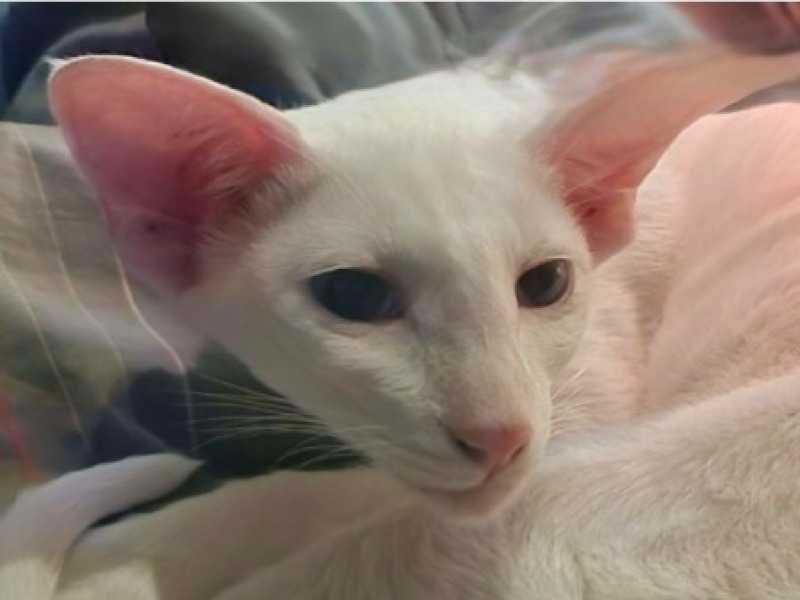Siamese
Welcome to our page dedicated to the breed of cat siamese!
Here, you will find all the useful information about siamese. This descriptive profile will allow you to discover the aspects of this breed. You can notably consult information about the average price, monthly and annual upkeep expenses, their health, name ideas, as well as their official recognition by competent authorities.
Explore this page to discover everything you need to know.
Overall description of the breed
The Siamese cat breed is a true gem of the Orient, whose elegance and temperament have captured the hearts of many cat lovers around the world. Its fascinating history, distinctive traits, and unique personality make it one of the most iconic and beloved feline breeds.
The history of the Siamese cat dates back to the regions of Southeast Asia, particularly Thailand (formerly Siam), from where it gets its name. With a royal heritage, the Siamese cat was revered in Thai temples, where it was considered a sacred guardian. Its mystical aura and exotic beauty contributed to its reputation.
While the Siamese cat is widely appreciated today, its popularity in the West is owed to the introduction of the breed to the United Kingdom in the 1880s. The King of Siam (modern-day Thailand) gifted several Siamese cats to British diplomats, who then brought them to England. These exotic cats generated enthusiasm and quickly caught the attention of breeders and cat enthusiasts.
Its beginnings in the West were marked by criticism, attributing a perceived difficult temperament to this cat and facing challenges in adapting to the British environment. Moreover, due to the low number of Siamese cats at the time, inbreeding contributed to reinforcing this supposedly "difficult" trait and resulted in genetic anomalies. Nevertheless, despite these challenges, their population rapidly increased, leading to the official recognition of the Siamese cat in the UK in 1936.
The ancestors of the Siamese cat were cats with a similar appearance, characterized by their short coat, slender body, and graceful demeanor. However, the most striking feature of the Siamese cat is undoubtedly its pointed colors, which vividly contrast with the light cream coat of the rest of the body. Originally, only chocolate and seal (black) colors were present, but over the years, new colors were developed through selective breeding.
The morphology of the Siamese cat is elegant and slender, with a muscular and lithe body. The almond-shaped eyes are deep blue and striking, giving the cat an expressive and captivating gaze. The ears are broad at the base and taper to a point, adding to the Siamese cat's exotic appearance.
The point colors of the Siamese cat manifest at the extremities of the body, particularly on the face, ears, legs, and tail. In addition to chocolate and seal colors, new colors were introduced over time, such as blue (gray), lilac (pale gray), and lynx point (with tabby stripes).
The character of the Siamese cat is just as captivating as its appearance. These cats are often described as talkative, expressive, and affectionate towards their owners. They enjoy interacting with people and tend to express their opinions using melodious meows and purring. Siamese cats are also intelligent and curious, making them fascinating companions.
The average weight of an adult Siamese cat usually ranges between 2.5 and 4.5 kg (5.5 to 10 lb). Regarding size, Siamese cats are typically medium to large, with an average length of 30 to 35 cm (12 to 14 inches).
The founding breed club of the Siamese cat is the Siamese Cat Club, established in 1901 in England. This club played a key role in promoting and preserving the Siamese breed by setting breed standards and organizing cat shows.
As for global recognition, the Siamese cat is one of the oldest and most recognized feline breeds in the world. It is widely accepted by renowned cat organizations such as the Fédération Internationale Féline (FIFé) since 1945 and the Cat Fanciers' Association (CFA). The FIFé established the breed standard for the Siamese cat in the early years of its existence, contributing to its international reputation.
In conclusion, the Siamese cat embodies the elegance, grace, and singular personality of the Orient. Its rich history, exotic appearance, and expressive character have captured the hearts of cat enthusiasts worldwide. As one of the most iconic cat breeds, the Siamese cat continues to charm and fascinate cat lovers with its mystical aura and timeless beauty.
Awareness of acquiring an animal
Each animal is a sensitive being, deserving love, attention and care.
When you choose to adopt an animal, you take on the responsibility of ensuring its health and well-being throughout its life.
To learn more about animal welfare, we invite you to consult our FAQ by clicking the button below:
Origins
The Siamese cat, with its distinctive elegance and piercing blue eyes, originates from Thailand, formerly known as Siam. This ancient breed was highly prized within the Thai royalty and often featured in religious and royal manuscripts, where it was celebrated for its beauty and unique personality.
History
Introduced to the West in the 19th century, the Siamese quickly captivated the imagination and hearts of cat lovers across Europe and North America. Known for its aristocratic bearing and affectionate temperament, it has gained enduring popularity, becoming one of the most famous cat breeds in the world.
Standard
The Siamese breed standard favors a slender and muscular body, thin legs, a triangular-shaped head with large ears, and almond-shaped eyes of intense blue. Its most distinctive characteristic is its color-pointed coat, with darker markings on the ears, muzzle, legs, and tail.
Physical characteristics
Siamese cats are slender and agile, with a graceful demeanor that reflects their energy and vivacity. Their short, silky coat accentuates the contrast between their cream bodies and their colored points, making each cat unique.
Character
The Siamese is known for its sociable, communicative, and sometimes demanding temperament. Very attached to its owners, it seeks interaction and does not hesitate to express its desires with a melodious and distinctive voice. It is a loyal and affectionate companion who enjoys company.
Life expectancy
With proper care, a balanced diet, and exercise, Siamese cats can enjoy a lifespan of 12 to 15 years, with some individuals even living up to 20 years.
Exercise and activity needs
Active and curious, the Siamese cat needs mental and physical stimulation to stay happy. Interactive games, food puzzles, and cat trees offer excellent opportunities for exercise and entertainment.
Recommended diet
A high-quality diet, rich in proteins and tailored to its specific nutritional needs, is essential to keep the Siamese healthy. Monitoring its weight is also recommended to avoid obesity.
Training and obedience
The Siamese is intelligent and capable of learning quickly. It responds well to positive reinforcement and can be trained to perform tricks, use a scratching post, and even to respond to its name. Gentle but firm training is recommended.
Behavior with children
The Siamese, with its affectionate and playful nature, generally gets along well with children. Its sociability makes it a cherished family member, capable of actively participating in family life. As always, interactions should be supervised to ensure everyone's safety.
Compatibility with Other Animals
The Siamese, with its sociable character and curious nature, generally adapts well to the presence of other household pets, including other cats and dogs, especially if it has been socialized from a young age. Its playful and friendly temperament can contribute to positive interactions, but careful introduction is recommended to ensure harmonious cohabitation.
Grooming needs
The Siamese's short and silky coat requires minimal maintenance, making grooming relatively simple. Weekly brushing is sufficient to remove dead hair and maintain the shine of its coat. Regular care of the claws, ears, and teeth also contributes to its overall health.
Health
Siamese cats are generally sturdy, but can be predisposed to certain genetic conditions, such as heart problems, kidney diseases, and respiratory issues. Paying special attention to preventing obesity and regular veterinary visits will help keep your Siamese healthy throughout its life.
Average price
The cost of purchasing a Siamese kitten typically ranges from 400 to 1200 euros, depending on the lineage, pedigree, and specific physical characteristics. Purebred Siamese cats from reputable breeders and intended for shows can cost more.
Expenses
The annual expenses for a Siamese cat, including high-quality food, veterinary care, grooming, and accessories, can amount to about 600-1200 euros. Veterinary expenses can increase depending on the specific health needs of the pet.
Name ideas
Exotic and elegant names like Cleo, Saphir, Nefertiti, Raja, or Luna may suit the mystical aura and distinguished appearance of the Siamese. These names reflect the ancient history and the noble character of the breed.
Legislation and regulation
There is no specific legislation or category classification that exclusively concerns the Siamese. However, owners are encouraged to follow local regulations regarding vaccination, neutering, and identification of cats.
Official recognition
The Siamese is officially recognized by all major cynological organizations, including the American Cat Fanciers Association (CFA) or the TICA (The International Cats Association). This recognition highlights the historical importance and purity of the breed.
Pedigrees
Pedigrees, attesting to the pure lineage and health history of the Siamese, are available from recognized breed clubs. These documents are essential for those interested in breeding, showing, or preserving the standards of the breed.
Destination and usage
The Siamese is primarily an exceptional family companion, appreciated for its affectionate nature, loyalty, and intelligence. It thrives in environments where it can interact closely with humans and be part of family life.
Prohibitions
No specific ban is associated with the Siamese breed. However, as with all cat breeds, special attention must be paid to their well-being, living environment, and appropriate socialization to ensure successful integration into society.
Breeders of Siamese
Want to see more breeders of Siamese?
Check out the page of our directory listing all breeders of SiameseClassified Ads of siamese
No of siamese classified ads are available on Preeders.
If you’re a breeder, sign up for free now and be the first to post a classified ad
Breed clubs of siamese
No of siamese breed clubs are currently registered on Preeders.
If you would like to highlight your breed club, sign up for free now and be the first to appear on this page.





